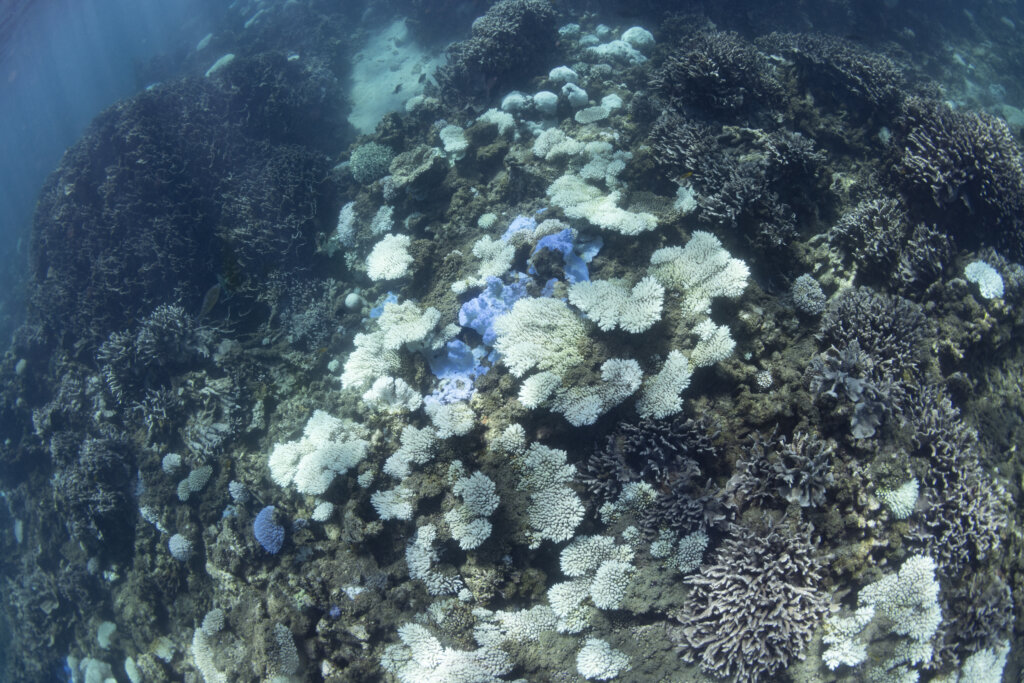What is happening to coral reefs off WA’s North West coast?
An Australian Institute of Marine Science (AIMS) report has revealed that the 2024/25 marine heatwave off Western Australia’s North West was the longest, largest and most intense on record for the state, resulting in bleaching coral reefs across 1,500 kilometres and killing corals at some sites at rates of more than 90 per cent.
This is by far the worst coral bleaching and underwater heatwave ever recorded in WA and is devastating for the Ningaloo Reef and Exmouth Gulf. Large areas particularly in the northern parts of the World Heritage Listed reef bleached and coral mortality is extensive. Fortunately, some areas have survived. Other coral reef systems such as Rowley Shoals have hit hard, with extensive and widespread mortality.
Scientists have been warning for decades that this would happen as a consequence of climate change, and it will get worse.
Why is bleaching so bad and how does it affect coral reefs?
When corals are under stress, they expel the symbiotic algae that lives in their tissues and provide them with food, nutrients, and colour, leaving a white ‘bleached’ skeleton behind. Most bleached corals will starve and are at high risk of mortality.
The full impacts of this bleaching event are unlikely to be known for two to three years as different species within these ecosystems are impacted by the coral loss that underpins their habitat.
Coral reefs support about a quarter of ocean life and also protect coastal areas from storms and provide many other invaluable services to nature and people. Bleaching can kill corals on a wide scale and have serious knock-on effects across ocean ecosystems, local economies and communities.

Coral bleaching at Tantabiddi, Ningaloo 2025. Image Blue Media Exmouth
What needs to be done to prevent it?
Ningaloo and coral reefs in general are coming under accelerating pressure from climate change in particular. Reducing carbon pollution is by far the most important action that needs to be taken. Not allowing new polluting fossil fuel projects like the Browse Basin around Scott Reef off WA – a reef that is also bleaching – is crucial, otherwise we make an obviously serious situation even worse.
We also need to protect places like Exmouth Gulf – Ningaloo’s nursery – from industrial threats like a port which is proposed for the area. We must do everything we can to reduce pressure on the Ningaloo ecosystem to protect it, particularly at this time. If nothing is done, reefs and communities will continue to suffer the heavy consequences of heating seas.
It’s distressing to see these natural wonders under such stress. It could not be a more serious moment for coral reefs, but also for the marine environment in general. The seagrass meadows, mangrove forests and the ocean ecosystem generally are under immense pressure now. Add the algal bloom off South Australia. It’s the most serious marine emergency we’ve ever seen in Australia.
Is it still worth visiting Ningaloo Reef?
Ningaloo Reef and Exmouth Gulf are still remarkable habitats that can offer tourists an amazing experience. We’re encouraging people to visit Ningaloo and see the bleaching first-hand, get behind the local tourism operators and towns, and to take inspiration from the healthy areas, and to support conservation efforts to protect these places.
Actions you can take now
Say No to an industrial port in Exmouth Gulf Stop
AMCS in the media
Key statement from Paul Gamblin, Executive Officer of the Australian Marine Conservation Society, regarding the marine heatwave:
“The vast scale of the impacts along WA’s coastline and offshore reefs is hard to comprehend – this is unprecedented harm and needs an unprecedented leadership response from WA and federal governments.
“Governments must commit to ending new fossil fuel projects, ensure climate is a core consideration in nature law reform, and double down on building the resilience of our marine environment through strong protection and restoration.
“Bleaching at Ningaloo is not just a tragedy for the reef’s marine life. It’s a loss for the local communities who depend on it for tourism, for Traditional Owners who have cared for these waters for tens of thousands of years, and for all Australians who treasure this World Heritage icon.
Learn more about marine heatwaves
https://www.marineconservation.org.au/marine-heatwaves/
Header image credit: Brooke Pyke @brookepykephotography